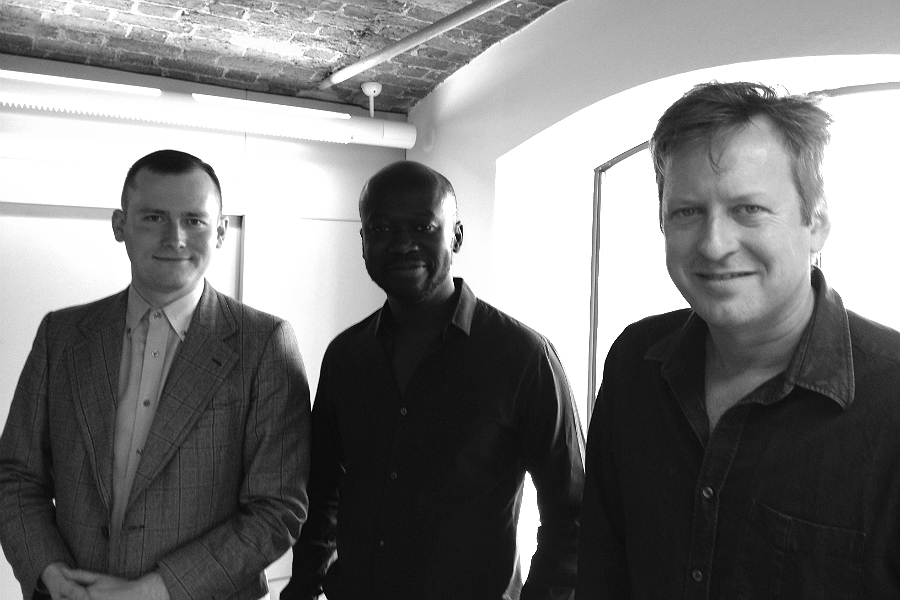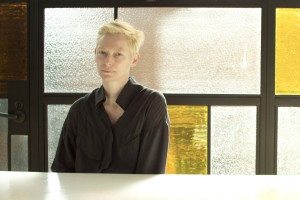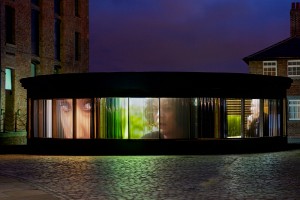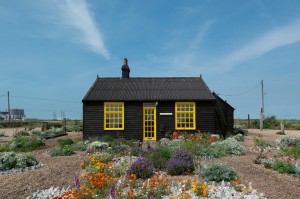Biennial 2012: Doug Aitken & David Adjaye in conversation

Liverpool-based architect Matthew Ashton sits down for tea, biscuits and a good chat about creative ideas in art and architecture with Doug Aitken and David Adjaye …
Tate Liverpool’s big Biennial commission, Sky Arts Ignition: Doug Aitken – The Source, is a collection of interviews with a myriad of cultural figures (including musician Jack White and actress Tilda Swinton, pictured below). The work is housed just outside the Tate in Mermaid Court in a temporary pavilion collaboratively designed by New York-based artist Doug Aitken, and British architect David Adjaye OBE. We thought Matthew Ashton, RIBA architect for MgMaStudio, Liverpool, would be the perfect person to meet both collaborators and get to the root of their creativity …
Matthew Ashton: I’m interested ultimately how you both came together…
Doug Aitken: Before we get started, you’re going to need a speed control, when David gets going he speaks so fast! When we were interviewing him [for The Source] he was speaking in sixth gear.
David Adjaye: I only do that for him!
Matthew: I’ll hold up a hand maybe and get a beat! (all laugh) Well, I suppose just leading on from what I was saying, the piece is fascinating because there’s a diverse range of practitioners there, each exploring their own very personal nature of the creative process. I’m really interested in your own personal creative processes – how you came together to collaborate on the pavillion, and is it a work based in a pavillion?
David: Doug has to take that!
Doug: No no no no!
Matthew: You guys are so polite to each other … (all laugh)
David: Doug was given the commission, let’s get that straight. Doug was commissioned by the Tate to do this piece for the Biennial. We’ve known each other for several years through the art world. It just seemed like the right time – we’ve always wanted to work with each other. I’m a huge fan of his, and I think he’s a huge fan of mine … so that was alright! This seemed like an opportune moment. When Doug started to talk about wanting to do this incredible multi-screened piece, well, I’d been seeing what he’d done recently at MoMA and at the Hirshhorn and was really blown away by it, the power and the social engagement and the publicness of the work and its intimacy. So it just seemed like a perfect moment to try another iteration in this historic city.
Doug: I think oftentimes things happen very organically. I’ve been following David’s work for a long time, and also he’s just a friend, a good friend, and when this situation came up, it was really necessary for this work to exist outside the museum [Tate Liverpool], and be really autonomous. I wanted it to be a space that was very open, very democratic, the viewer could really walk inside and feel empowered to make their own narrative, spend as much or as little time as they wanted with each individual within the work. So I think there were two necessities really, the work secedes from the museum, and also how do you make a space which does have a democratic viewing structure, where there’s not a hierarchy with a large screen or an order of importance.
David: This was incredibly important to me because of my work that’s a sort of ongoing theme, which is how can you enlarge and create public, collective groups and community. So in a way to do that with projection spaces, which are very hierarchical by their very nature, and also architecturally incredibly cellular, there are usually chambers that you go into.

Doug: Also you could say that the architecture of cinema is voyeuristic and passive – going into a space, sitting down in a comfortable chair, watching this narrative play out. I think that with this project we wanted something very different – it’s a tight space, you walk inside, if you go up to the centre of the space, usually the central architecture is where you find the order, but here it’s where you find the chaos.
Matthew: I experienced that earlier, it’s fantastic. There’s a beautiful quality of ripples of sound and you can’t quite glimpse everything. Very immersive, very successful.
Doug: Thank you. It kind of resembles an anarchistic dinner party. You walk in and you hear something over there, a snippet over here, it makes you curious, and you follow a trail that is of your own making.
Matthew: Maybe this is a good point to talk about the architecture of the pavilion. David, I’m really interested in these immersive environments that you create, in this charged space. Do you feel that this is a departure or a continuum for you?
David: I think there’s a central theme, and I think all the collaborations that I do are with people that share these common thresholds, so that it allows the work to naturally unfold … I am fascinated by working with artists that allow the artwork to become the device that eminates a new opportunity. What’s great is that with architecture you’re always dealing with the way the brief is structured … but with artworks, because it’s a unique piece, it demands getting to the point. So every time I collaborate with an artist it’s a ruthless, intellectual pursuit to make something extremely pure, as good as the artwork, so they can support each other. For me that always is a really great discipline, and I really thoroughly enjoy that, the banter, through technology or discussion, it’s like, woah, this is how something can evolve …
Doug: When I look at this pavilion there’s something about it that’s simple, it’s minimal, it’s raw, but at the same time it has a choreography to it. The choreography is what makes it unique, and really that’s your great contribution to it, the viewer has a rhythmic pattern that they follow, as they walk from room to room, it has a geometry to it, which I like, and I like the way the inside becomes the outside in the evening. It folds itself inside out.

Matthew: Is there any aspect of the context (maybe it’s climatic, maybe it’s the built environment) the way you approached the piece in this setting, is there any tension in that environment that you think adds to the piece?
David: I think the whole composition is not sort of singular or linear, it’s not the type of narrative that climaxes. I think that what’s beautiful is that it’s just a continuous loop that you enter and exit, and the pleasure of it is that it’s public space, that for me is its power. That actually it allows you to feel that there’s not something that you have to follow, that you can choose your own story once you’re in there. That’s the best kind of work for me.
Doug: That’s also getting back to this idea of why or why not this structure is not inside an institution. When I look at it, its shape, form, structure and content, I see it almost as an archaeological dig, an excavation of sorts. You know, this is the shelter, the pavilion that you walk inside, but the excavation is not of a material kind, it’s of a conceptual kind. It’s the archaeology of ideas, concepts, references and how this, like, raw matter, really, than takes shape, form and structure, and becomes something, whether that’s cinema, architecture, contemporary art, music or anything else.
Matthew: I was fascinated by the simplicity, the humble threshold, the rawness of the materiality, and the number and the range of participants, it’s really engaging.
Doug: It was really great to have filmed a conversation with David and then to have this experience of building the structure, bringing the whole thing full circle. Here you have David talking about the tempos of music, and different forms of music, and how that relates to his architecture, and then you’re standing in this pavilion that has this rhythm to it, seeing language become form – in this instance it was really special. So good job David!
Sky Arts Ignition: Doug Aitken – The Source is at Tate Liverpool until 13 January 2013





